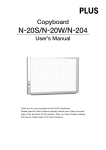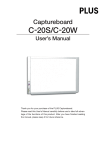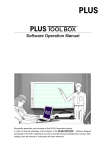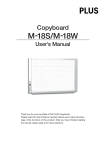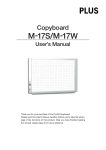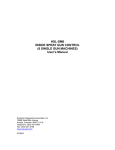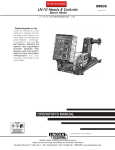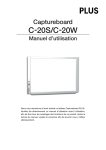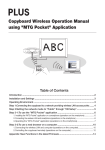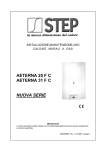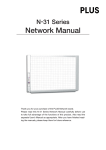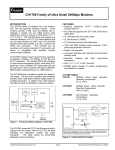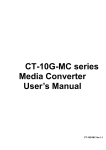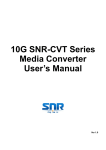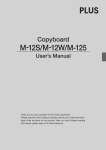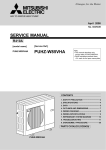Download Manual - Plus America
Transcript
Copyboard N-20J User’s Manual Thank you for your purchase of the PLUS Copyboard. Please read this User’s Manual carefully before use to take full advantage of the functions of this product. After you have finished reading the manual, please keep it for future reference. Introduction This manual is for the N-20J model. The descriptions and diagrams in this manual refer to the model N-20J. * When functions or operations are specific to a certain model of copyboard, the model name is specified. Cautions on using networks About the network connection environment • The required operating environment is subject to change without notice. Also, PLUS does not guarantee all operations. • Even if all required operating environment conditions are met, it may happen that operations do not work properly or that some problems arise. Depending on the communications status, displays may be delayed and communication errors may occur. Disclaimer • PLUS will accept no responsibility whatsoever for any consequences of problems of communication impediments in connected devices due to the network functions. • PLUS will accept no responsibility whatsoever for impediments incidental to usage of or the inability to use the network functions (loss of business profits, losses due to interruption of activities, etc.). • PLUS will accept no responsibility whatsoever for malfunctions due to combinations with connected devices or the software used, nor for damages arising from hang-up, etc. NOTE Do not use ruled type tapes. Do not move the sheet with tape, etc., attached to it. Doing so could result in malfunction. Do not attach template sheets or paper to the sheet. Do not copy while film-type objects or papers are attach to the sheet. Doing so could result in malfunction. Trademarks • Microsoft and Windows are registered trademarks or trademarks in the United States and other countries of the Microsoft Corporation. • Adobe and Adobe Acrobat Reader are trademarks of Adobe Systems Incorporated. • Safari, Apple, Mac OS and Macintosh are trademarks or registered trademark of Apple Computer, Inc., of the United States. The trademarks of the various companies and the product trademarks, even when not written down, will be given due respect. Product names and company names appearing in this manual are registered trademarks or trademarks of the respective companies. (1) The contents of this manual may not be reprinted in part or whole without permission. (2) The contents of this manual are subject to change without notice. (3) Great care has been taken in the creation of this manual; however, should any questionable points, errors, or omissions be apparent, please contact us. (4) Notwithstanding Section (3), this company will not be responsible for any claims of loss or profit or other matters deemed to be the result of using this unit. (5) The use of a printer as the peripheral device of the PLUS Copyboard is taken to be a prerequisite; therefore, operation will not be guaranteed when the printer is used with a direct connection to a personal computer. (6) Manuals with incorrect collating or missing pages will be replaced. E-2 Table of Contents Introduction................................................................E-2 Package Contents.......................................................E-4 Names of the Parts.....................................................E-5 Front....................................................................... E-5 For stand sets with a printer table (sold separately).... E-5 Input/output terminals.............................................. E-6 Changing the Height of the Unit (stand sold separately)............................................................... E-7 Control Panel (Model N-20J)..................................... E-8 Functions of the Copyboard.......................................E-9 Basic Functions....................................................... E-9 Network Functions................................................... E-9 Network remote control function............................... E-9 Operation Steps........................................................E-10 Setting the Time........................................................E-11 Description of Operations....................................... E-11 Printing (printer sold separately).............................E-13 Preparing the Printer.............................................. E-13 Basic Printing Operation......................................... E-14 Moving the sheet surface manually......................... E-16 Using USB Memory...................................................E-17 USB Memory Storage Procedure............................. E-17 Saving Image Files on a Computer/Deleting Image Files...................................................................... E-19 Using the copyboard connected to a computer......E-21 Using the Copyboard Connected to a Network........E-23 Saving scanned images on the copyboard or FTP server................................................................... E-23 Transferring image files to/deleting them from the computer............................................................... E-25 When the folder for saving is set to “Board”....... E-25 Deleting image files from the copyboard............ E-27 When the folder for saving is set to “FTP Server”............................................................ E-28 Deleting image files on the FTP server............... E-29 CB Setup and Network Setting Procedure...............E-30 CB Setup (operating the copyboard’s buttons).......... E-30 Basic setting operation..................................... E-30 Table of Function Numbers and Settings............ E-31 Simple Network Settings (via USB).......................... E-33 Making Detailed Settings (via LAN).......................... E-35 Basic Setting Operations................................... E-35 CB Setup......................................................... E-38 Header/Footer.................................................. E-39 Network Setting............................................... E-40 User Setting..................................................... E-41 Security Setting................................................ E-42 Disk management Setting................................. E-43 CB Information................................................. E-43 Resetting the Network Settings......................... E-44 Creating and Registering Headers and Footers... E-45 Meaning of Error Messages.....................................E-46 Troubleshooting........................................................E-48 Specifications...........................................................E-50 Appendix...................................................................E-51 Connections and Wiring Diagram............................ E-51 Meaning of the Terms Used in this Manual • Main unit (or set): This refers to the copyboard. • USB memory: refers to USB flash memory. • USB memory storage: means the saving of sheet surface data using MEMORY (i.e., the USB port) of the operation panel. • Memory for computer storage: indicates a temporary saving location of the image that has been read. • “copy”: Both “print” and “USB memory saving” mean to “copy.” • “Sheet surface”: refer to the drawing portion. • “Scroll” or “move”: indicates feeding of the sheet • Memory for network storage: Memory used for network storage. • Network: The communications network on which devices are interconnected in net fashion for communication (exchange of data) between the devices. For this copyboard, the “network” indicates the LAN below. • LAN (Local Area Network): A closed communications network for communicating within a restricted area, such as within a company. • FTP (File Transfer Protocol): The protocol (communications rules) used when transferring files on a TCP/IP network. E-3 Package Contents The package contents are as described below. Please check before use. Main unit [1] Wall brackets [1 set] Printer* [1] Please see the instruction manual of the printer for information about the printer accessories. * Depending on the type of product you have purchased, the printer may be sold separately. These are brackets for mounting the main unit on a wall. (See the Assembly and Setup Manual.) Stand [1] A mobile stand (with casters) for supporting the main unit. A printer table and AC adapter box are included. For the contents of the stand’s package and instructions on assembly, see the stand’s instructions or the separate Assembly and Setup Manual. Lower wall brackets: 2 Upper wall brackets: 2 Main unit fixing screws (M4 × 12: 2) * Sold separately for some products. Pen tray [1] Pen tray fixing screws (M4 × 20) (temporarily fastened on main unit) N-20J: 3 screws (See the Assembly and Setup Manual for assembly instructions.) Adapter holder [1] The AC power adapters of the copyboard and printer can be stored here. (See the Assembly and Setup Manual). USB cable(3 m) (type B ↔ type A) [1] [PLUS code 715258900] Copyboard Accessories Dedicated markers (One each of black, red, blue, and green) Use these markers to draw on the sheet surface. Cable for connecting the main unit to a computer. Used for making the device settings. Notice Dedicated eraser [1] Use this to erase the drawing. • Do not use this cable for connection to the printer (sold separately). AC power adapter (with power cord) [1] This is the power adapter for supplying power to the copyboard (See Page E-51). (LTE36E-S2-3) Documents CD-ROM [1] Includes the User’s Manual (this manual) in PDF format. The User’s Manual contains instructions on using the copyboard. Important Safety Information [1] Includes instructions to be heeded in order to use the set safely. Notice • The included AC power adapter and AC power cord are exclusively for use with this unit. Never use them with other products. Assembly and Setup Manual Includes instructions on installing the set and connecting it with the printer (sold separately). E-4 Names of the Parts Main unit Front Frame cover Sheet Dedicated markers are used on the sheet to draw diagrams and to write. Control panel (See Page E-8) Adapter holder Pen tray This is a case on which the AC power adapters can be placed. Input/output terminals (see next page) * Located on the bottom surface. Stand (sold separately) This is a stand for supporting the copyboard. (See the Assembly and Setup Manual). * This illustration does not show the connection cords. For stand sets with a printer table (sold separately) Printer table (with AC adapter box) This is a stand specifically for placing a printer. The AC power adapters of the copyboard and printer can be stored in the AC adapter box. (See the Stand Assembly Manual). Effective Reading Size The area that can be copied is the gray area of the diagram. approx. 5 mm Note approx. 10 mm • It might not be possible to print or copy when storing to USB memory or personal computer any portions that are drawn outside of this range. approx. 10 mm Effective reading size approx. 5 mm E-5 Names of the Parts Input/output terminals USB memory port (type A) Insert a commercially available USB memory device here. Scanned images can be saved. (See page E-17) The connector is located on the bottom surface of the main unit. The diagram view is seen from the bottom. * This illustration does not show the printer or connection cords. DC input connector Connect this with the DC plug end of the AC power adapter. (See Page E-51.) (Only connect the supplied AC power adapter; nothing else.) Personal computer (PC) dedicated USB port (Type B) Connect this with the USB port (type A) of the PC. Used to connect the copyboard to a computer to make the copyboard’s device settings. Can also be used to copy scanned images onto the computer. (See page E-21, E-33.) LAN terminal (RJ-45) Connect to a LAN port on the network (switching hub, etc.) using a commercially available LAN cable. Printer connector (USB port Type A) Connect this with the USB connector of the printer (See Page E-51). (The printer connector is dedicated for use with a printer; use it only with a printer.) Locking/unlocking the stand’s casters After installation, lock the casters with the stoppers. When moving the stand, unlock the caster’s stoppers. The stoppers are locked when the bottom is pressed. Press the top to unlock them. Unlock Lock Caster E-6 Names of the Parts Changing the Height of the Unit (stand sold separately) This is the height adjustment when setting up the copyboard on the optional stand. The stand height can be adjusted to 2 levels by 250 mm. CAUTION • At least two persons should hold the main unit. If not, the main unit could drop or tip, resulting in accidental injury. • Lock the stand’s casters by pressing the bottom of the caster lock button. If not, the stand could move while the main unit is being mounted or removed, resulting in accidental injury. • After unplugging the power cord from the wall power outlet, disconnect all the connection cords from the set’s input/ output terminals. If the set is removed without disconnecting the cords, it could tip, resulting in accidental injury. • If a printer is mounted on the set, remove the printer before starting. If not, the stand could tip while the main unit is being mounted or removed, resulting in accidental injury due to the printer dropping or tipping over. (1)Unplug the power cord from the wall power outlet, then disconnect all the connection cords from the main unit. (2)Remove the locking knobs (one on each side). (3)Change the position of the main unit support pieces. Lift the main unit about 1 cm to unhook it. Insert the stand’s hooks securely into in the mounting holes in the main unit’s support pieces (one on each side). (4)Fasten the two locking knobs (left and right) to the mount support pieces. (5)Connect all the connection cables. Mounting hole Rear frames Hook lock-screws Stand lock-screw * This illustration does not show the connection cords. E-7 Names of the Parts 6 Save ( Control Panel (Model N-20J) ) button (USB memory storage) The sheet is moved by 1 screen and read, and the image is stored on the USB memory device. When connected to a computer by USB cable, the image is stored in the copyboard’s internal memory. When pressing a button, please press the center area (the square bulge). The button may not work if it is pressed on a corner. 7 Network ( ) button Scrolls and scans the sheet one screen’s worth and saves the data in the folder for saving. The data is saved either on the copyboard or in a folder on the FTP server, as previously set. 2 8 Scroll/Stop ( ) button Scrolls the sheet one screen portion left, then stops automatically. A press of this button while scrolling will stop the scrolling. 9 USB A Memory port (USB Type A) 3 Saves in commercially-available USB memory images that have been read by the copyboard. 4 5 7 6 10 Status These indicators notify of errors in the copyboard, USB memory device, network or printer according to whether they are lit or off and how they light (see table below). When the copyboard is functioning properly, the status indicators are lit green. (See table below) Also check the error message on the display window. For error information and remedies, see page E-46. 8 Display window Meaning USB indicator Printer indicator Printer problem 1 Off Lit red Lit red Off Flashing red Flashing red Off Off An unsupported printer is connected USB Memory not recognized 10 USB Memory storage problem USB memory not connected 9 Memory is full Warning that disconnection of USB memory has been forgotten 1 ON/Standby ( Reading error ) button System error Turns the copyboard’s power on and off (standby mode). 2 Display window Time setting error The number of copies, operating status and error messages are displayed on the 7-segment LEDs. 3 Number of Copies ( Security protection )/Test print button Color printed prohibited Press this button to set the number of copies to be printed (max. 10). The number of copies is displayed on the display window. * “ ” is displayed during test printing. 4 Color Print ( LAN cable disconnected FTP server recognition error ) button FTP server connection failure The sheet is moved by 1 screen and read, and the image is printed in color in the number of copies indicated on the display window. 5 B/W Print ( FTP server writing failure Network or other error ) button Network setting reset error The sheet is moved by 1 screen and read, and the image is printed in black and white in the number of copies indicated on the display window. Header/footer writing error * The letters “USB” scroll on the display. E-8 Functions of the Copyboard Basic Functions ① Printing ② Storing on USB memory devices ③ Capturing images on a computer Storing on USB memory device Output to paper Storing of image on computer Network Functions ④ Viewing images stored on the copyboard ⑤ Viewing images stored on an FTP server via via a network a network Copyboard’s memory Viewing of images stored on the copyboard LAN LAN Viewing of images stored on FTP server Network remote control function The copyboard can be controlled remotely from a smartphone or computer, and images on the copyboard’s sheet surface can be stored on the smartphone or computer wirelessly. For details, see “Copyboard Wireless Operation Manual using “MTG Pocket” Application”. E-9 Operation Steps The copyboard uses an image scanner to scan characters or diagrams drawn using special markers (four colors). When the Color Print or B/W Print button is pressed, the image on the screen is printed out to the printer. When a USB memory device or computer is connected, the image on the screen is saved as image data when the Save button is pressed. (For the memory for computer storage, one sheet’s worth of data is saved, overwriting previously saved data.) Furthermore, when network settings are made, image files can be saved on the copyboard or FTP server. Preparation • Set up the newly purchased copyboard and connect a printer. See a separate manual titled “Assembly and Setup Manual.” • Plug the AC power plugs of the copyboard and printer into wall power outlets. • After purchase, be sure to set the copyboard’s clock. If not, the proper date and time will not be displayed on prints or in image files. See page E-11. Draw on the Sheet Surface Saving to USB Memory Please draw with the dedicated markers that have been supplied. If anything other than the dedicated markers or eraser are used, it may be impossible to erase the sheet or the sheet could get dirty. To move the sheet manually, see “Moving the sheet surface manually” on page E-16. (1) Press the ON/Standby button of the copyboard to switch on the power. (2) Insert USB memory into the Memory port (USB A port) of the copyboard. (3) Press the Save button. See “Using USB Memory” on Page E-17. Saving on a computer (1) Press the copyboard’s ON/Standby ( ) button to turn the power on. (2) Connect the copyboard to the computer using the PC dedicated USB port. (3) Press the Save ( ) button. (4) The image is saved on the computer. Printing (1) Set A4 or letter size paper. Do not set anything other than A4 or letter size paper. (2) Press the ON/Standby button of the copyboard and switch on the power. (3) Switch on the printer power. For instructions on operating the printer, see the printer’s operating instructions. (4) Press the Color Print or the B/W Print button. The copyboard will move a one-screen portion of sheet, read the image, and start the copy operation*. See “Printing” on Page E-13. Using a network (via LAN) (1) Check that the copyboard is connected to a LAN port on the network. (2) Press the copyboard’s ON/Standby button to turn on the power. (3) Press the Network button. See “Using the Copyboard Connected to a Network” on page E-23. When Not Using the Copyboard (1) By all means, cleanly erase the drawing from the sheet surface with the dedicated eraser. (Leaving the drawing for a long period will make it harder to erase.) (2) Press the ON/Standby button of the copyboard and switch off the power (standby mode). The power cannot be switched off while the USB memory remains installed. (This is a prevention function against forgetting to unplug the USB memory.) (3) Switch off the printer power. Note • When turning on the power, wait about 5 seconds or more after the power plug has been connected before pressing the ON/Standby button. • The color of the images when printed in color or when saved in USB memory will differ somewhat from the marker colors. • Blurred characters, thin lines, overlapping of markers and other factors can cause colors to differ in places and can also result in portions that cannot be scanned successfully. • The data in the memory for computer storage is deleted when the ON/Standby button is turned off (standby mode) or the connection with the computer is cut. The data in the memory for network storage is not deleted. E-10 Setting the Time The date and time are stamped on the printing paper and recorded in the file information when files are stored on the copyboard and FTP server, so set the copyboard’s time correctly. The time can also be set from a computer via a network (when connected to a LAN). (See page E-38.) Description of Operations 1 2 Switch to “CB Setup”. With the power turned on, press the Number of Copies button while pressing the ON/Standby button, then release the ON/Standby button. Press the Save button and switch to “Time Setting”. The mode switches each time the Save button is pressed. Contents of setting mode displayed on display window (First 2 digits) (Last 2 digits) Christian year 3 4 5 Month Day Hours Minutes Set the setting mode’s date and time. When the Color Print or B/W Print button is pressed once, the setting can be made. Use the Color Print (Increase) and B/W Print (Decrease) buttons to set. Press the Save button to enter the setting. The copyboard switches to the next setting position. Repeat steps 4 and 5 to set the current date and time. • If the ON/Standby button is pressed during steps 3 to 5, the partially made setting is canceled and the date and time return to the values set before the setting was started. Complete the setting. When the Save button is pressed after the minute’s setting position (c.6 display) has been set, the “Time Setting” is completed and the [F1] display (CB Setup) reappears. Press the ON/Standby button to return to the normal mode. Preparations : Connect the power plug to a wall power outlet (AC 100–240 V). [Example]: Setting the date and time to 2:16 pm October 8, 2012 Press the ON/Standby button to turn on the power. The display window’s LEDs light and the power turns on. Normal mode Press the Number of Copies button while pressing the ON/Standby button, then release the ON/Standby button. The mode switches to “CB Setup”, and “F1” is displayed on the display window’s LEDs. The mode returns to the normal mode if no buttons are operated for 10 seconds. E-11 “CB Setup” mode Setting the Time While “F1” is displayed, press the Save to enter. button The display switches to “c1” (first 2 digits of year). If no buttons are operated for 10 seconds while in the time setting mode, the mode returns to the “CB Setup” mode. Press the Save its of the year button to move to the last dig- The display switches to “c2” (last 2 digits of year). Notice: The first two digits of the year (“20”) are fixed. Simply press the Save button to switch to the last 2 digits of the year setting position. Use the Color Print (Increase) and B/W Print (Decrease) buttons to select “12” (the last 2 digits of the year), then press the Save button to enter. The display switches to “c3” (setting of month). Use the Color Print (Increase) and B/W Print (Decrease) buttons to select “10” (the month), then press the Save button to enter. The display switches to “c4” (setting of day). Use the Color Print (Increase) and B/W Print (Decrease) buttons to select “08” (the day), then button to enter. press the Save The display switches to “c5” (setting of hours). Use the Color Print (Increase) and B/W Print (Decrease) buttons to select “14” (the hours), then button to enter. press the Save The display switches to “c6” (setting of minutes). Use the Color Print (Increase) and B/W Print (Decrease) buttons to select “16” (the minutes), button to enter. then press the Save The display switches to “F1” (function setting). Press the ON/Standby normal mode. button to return to the • The copyboard also returns to the normal mode if you just wait 10 seconds. This completes the time setting. E-12 “CB Setup” mode Normal mode Printing (printer sold separately) Use a printer (sold separately) to print the data on the sheet surface. Use a PLUS-designated printer. Operations and names of parts differ from printer to printer. For details of operations, see your printer’s operating instructions. Preparing the Printer Please check that the copyboard and the printer have been connected. See Page E-51. Set the paper. Power switch Please use A4 or letter size printer paper. • When using letter size paper, set letter size paper in the device settings. (See page E-31, E-38.) 1)Arrange the paper edges so that they are even. 2)Insert paper at the specified position of the paper tray. 3)Press the paper guide gently until it touches the paper. Paper guide Note See your printer’s operating instructions for a description of the paper that can be used. Notice Paper • Depending on the printer’s specifications, some time may be required for cleaning of the print head. Paper tray Discharge tray Appearance of printer is for illustration purposes. Switch on the power. Press the power switch. The power indicator lights. This completes the preparation of the printer. Press the Color Print or the B/W Print button on the copyboard’s control panel. One page worth of data is read and the printing operation starts. Notice • Depending on the printer, indicators, etc., may flash after the power is turned until the printer is prepared to print. In this case, see the printer’s operating instructions and check that the printer is ready before starting the printing operation on the copyboard. When finished printing... Switch off the printer power and remove the paper. Close the paper tray. Notice • Caution: Do not turn off the power or disconnect the USB cable during printing. E-13 Printing Model name: N-20J Basic Printing Operation Preparation: Preparation: Check that the AC power plugs of the copyboard and printer are connected to wall power outlets. Press the ON/Standby button and switch on the power. Prepare the printer. (See the previous page.) Note • When turning on the power, wait about 5 seconds or more after the power plug has been connected before pressing the ON/Standby button. • Press the ON/Standby button to switch on the power. The LED of the display window will light. • Turn on the copyboard’s power before turning on the printer’s power. Press the Scroll/Stop face you want to print. button and display the sheet sur- There are two screens. When the Scroll/Stop button is pressed, the sheet surface scrolls one screen’s worth to the left (to the next screen) and stops automatically. Note • To display the next screen, press the Scroll/Stop button after scrolling stops. If the button is pressed during scrolling, scrolling stops immediately. When pressed again, the sheet is scrolled one screen’s worth from the point at which it stopped. • The one-screen that is visible is printable position. • To fine-adjust the sheet surface position, with the sheet stopped, move the sheet slowly by hand. The sheet can be moved either to the left or to the right. • Printing of the portion located around the sheet surface might not be possible. Please see “Effective reading size” on Page E-5. continued on next page E-14 Printing Press the Number of Copies button and select the number of copies. Note • “01” is selected when the power is turned on. • Up to 10 copies can be specified and displayed on the display window. • The number of copies increases by 1 each time the Number of Copies button is pressed, and “ ” is displayed after “10” (this is used for test printing: see page E-49). When the button is pressed again, the display switches to “01”. The number switches continuously if the button is held in. • After setting the number of copies, proceed to step 4 within 1 minute. The number of copies is reset to “01” if no operation is performed within 1 minute. Press the Color Print or the B/W Print button to print. or • The reading operation is performed for a one-sheet portion (while the sheet is scrolled) and the printing operation is performed. Cancellation of the print operation in progress When the ON/Standby button is pressed, the reading of the sheet stops, and the partially read image data is printed. Wait until the sheet is expelled from the printer. Note • If the ON/Standby button is pressed while the sheet surface is being read, printing is interrupted and only part of the image will be printed. • The one-screen portion is reduced to A4 paper size and printed. • A flashing “ ” in the display window indicates a print error. See “Meaning of Error Messages” on Page E-46. • When printing, a time stamp (date and time) is printed at the top right of the sheet. See “CB Setup” on page E-30, E-38. When the copyboard is not going to be used, press the ON/Standby off the power (standby mode). button and switch • When the power is turned off, scanned images stored in the unit’s internal memory are cleared. • Switch off the printer power. Note • When the Erase Reminder function is set to “Enable” When the ON/Standby button is pressed, the display window and all the indicators flash simultaneously, the sheet automatically moves to the surface that is not yet erased and the power turns off. To set the Erase Reminder function to “Disable”, see page E-32, E-38. * The Erase Reminder function may not work properly due to dirt on the sheet's adhesive sections or marker residue. • If no button is operated within 30 minutes, the power turns off automatically (auto power off). • The auto power off function is canceled when the copyboard and computer are connected by USB cable. E-15 Printing Moving the sheet surface manually The sheet can be moved even when the power of the copyboard is switched off. The sheet can be moved with your hand either in left or right. Please place your hand at the vertical center and move the sheet slowly. Notice • Quick movement can cause damage to the drive mechanism of the copyboard. • When the sheet surface is moved, roller traces may appear on parts of the screen. Note • When the Erase Reminder function is set to “Enable”, the Erase Reminder function may not operate properly if the sheet surface is moved by hand. E-16 Using USB Memory The content of what has been drawn on the sheet surface of the copyboard can be saved in USB memory. Later, the saved image can be read into a personal computer and made into a document of the proceedings of the meeting, or affixed to a document. Notice • No USB flash memory device is included. When purchasing a USB flash memory device, pay attention to the following: 1.USB flash memory devices formatted in FAT16/FAT32 are supported. USB flash memory devices in NTFS format cannot be used. 2.USB flash memory devices protected by a security function cannot be used. 3. USB memory devices with multiple drives or partitions cannot be used. USB Memory Storage Procedure Preparation: Check that the copyboard’s AC power plug is connected to a wall power outlet. Model name: N-20J Press the ON/Standby button and switch on the power. Note • When turning on the power, wait about 5 seconds or more after the power plug has been connected before pressing the ON/Standby button. • Press the ON/Standby button to switch on the power. The LED of the display window will light. Insert the USB memory device into the USB A Memory port of the copyboard. Notice • Check the side (polarity) of the USB memory device before inserting it. Forcing it in the reverse orientation will damage the USB A Memory port or USB memory device. • Be careful not to bump into the USB memory device with hand or body while it is mounted. Doing so could damage the USB memory device or USB A Memory port. Press the Scroll/Stop stored. button to display the screen to be The procedure for displaying the sheet surface you want to store is the same as for printing. See “Basic Printing Operation” on page E-14. Note • The one screen portion that is viewable will be saved in USB memory. • Saving of the portion located around the sheet surface might not be possible. Please see “Effective reading size” on Page E-5. continued on next page E-17 Using USB Memory Press the Save button to store. Flashing indicator “rotates” sequentially during USB memory storage operation. Display window • When the USB memory device is connected, the USB Status indicator on the main unit display panel lights green. Check that it is lit before pressing the Save button. • The reading operation is performed for a one-sheet portion (while the sheet is scrolled) and USB memory storage starts after the scrolling completes. The (5 second) flashing “US” display indicates that the USB memory has not been inserted. Please insert the USB memory and then press the Save button. A (5 second) flashing “FL” display indicates that there is insufficient free capacity to permit storage in USB memory. Replace with a USB memory device having sufficient capacity. See “Meaning of Error Messages” on Page E-46 for other error displays. Note • Depending on the USB memory, it may take time for recognition or it may take time for saving. • When the ON/Standby button is pressed during the reading operation, the reading operation will be discontinued and the partially read image data will be stored in the USB memory. To move the sheet surface, stop scrolling, then press the Scroll/Stop button. • The date and time of the saved file will reflect the copyboard time setting. See “CB Setup” on Page E-31. • When the copyboard and a computer are connected by USB cable, the data is stored in the main unit’s internal memory. Note that it is not stored in the USB memory. Removing the USB memory Check that the flashing rotation of the display window has changed to steady lighting and that the USB memory access indicator is not flashing, then pull the USB memory straight out. (Please see your USB memory manual for details.) Notice • Do not unplug the USB memory device during the USB memory storage operation (i.e., during the rotating, flashing display in the display window), or while the access indicator of the USB memory device is flashing because data will be destroyed. When the copyboard is not going to be used, press the ON/Standby off the power (standby mode). button and switch Note • “ ” letters appearing at one-second intervals in a moving display in the display window indicate that a USB memory device is mounted. Unplugging the USB memory device will switch off the power. (A function that serves as a reminder to unplug the USB memory device) • When the copyboard and a computer are connected by USB cable, the auto power off function (which turns the power off automatically) is canceled. • Scanned image files stored in the memory for computer storage are deleted when the ON/Standby button is turned off. Files in the memory for network storage are not deleted. E-18 Using USB Memory Saving Image Files on a Computer/Deleting Image Files Examples of operations follow for saving the image files in the USB memory device to the hard disk of the personal computer, and for deleting the folder when the USB memory capacity is full. (There are various methods that can be used for saving and deleting including the use of Explorer.) See the instruction manual of your personal computer or the software that you are using for information about using a personal computer. The name of the folder on the USB memory device is “CB_Image”. Image files are stored in this folder. By factory setting upon purchase, image files are named “PV-xxx.png” (PNG files), where “xxx” refers to a 3-digit number starting from 001 (ex.: PV-001.png). Images can be stored in JPEG, PNG or PDF format, selectable in the copyboard settings (“CB Setup”). (See pages E-31, E-38.) Plug the USB memory device into a USB port of the personal computer When connecting to the personal computer for the first time, the installation of a USB driver is required. Follow the instructions manual of the USB memory device that you are using. • Usually, with Windows XP/Windows Vista/Windows 7, the standard driver is installed automatically and the copyboard is identified as “Removable disk” in “My Computer” (or “Computer”). Saving the image files of a USB memory device to a personal computer 1. Open “My Computer” (or “Computer”) and from within, open the drive of the connected USB memory device. The folder named “CB_Image” is the saved data of the copyboard. 2. Store the “CB_Image” folder in “My Documents” or another location. All of the data contained in “CB_Image” will be stored. Notice Depending on the computer’s usage environment, these operations may not work properly. This could be the case for example: • when several USB devices are connected simultaneously to the computer. • when the USB device is connected to a USB hub or when it is connected using an extension cable. Drag to My Documents continued on next page E-19 Using USB Memory Deleting USB memory image files with the computer Before deleting important image files, be sure to save them on the computer (as a data backup). 1. Open “My Computer (or “Computer”)” and then open the drive icon which shows USB memory. The folder named “CB_Image” contains the memory storage data of the copyboard. 2. Place the “CB_Image” folder in the “Recycle Bin”, right click on the icon and select “Empty Recycle Bin” from the pull-down menu. All of the data contained in “CB_Image” will be deleted. Even when the entire folder is deleted, a new CB_Image folder will be created automatically when USB memory is used again with the copyboard. Drag to the Recycle Bin Disconnect the USB memory The disconnecting procedure depends on the computer’s operating system. For details, refer to the computer’s operating instructions or help files. 1. Click the [Hardware Removal] displayed in the task tray. icon that is Click “Stop USB Mass storage Device - drive (E)”. (The E drive character will differ depending on the personal computer system.) 2. When the “USB mass storage device can be safely removed.” screen is displayed, click the display. 3. Click [X] to close. This allows the USB memory device to be unplugged from the computer. Note • Do not disconnect the USB memory device while the USB memory device’s access indicator is flashing. Doing so will damage the data. • The USB drive may not be disconnected properly, for example if the computer is in the process of checking the status of peripherals. E-20 “Remove hardware” icon (example) Using the copyboard connected to a computer When the copyboard and a computer are connected by USB cable, the copyboard is recognized as an external memory device (removable device). Below is the procedure for copying the “CBImage” file from this device onto the computer. Images can be stored in JPEG (.jpg), PNG (.png) or PDF (.pdf) format, selectable in the copyboard settings (“CB Setup”). (See pages E-31, E-38.) The factory default is “PNG”. CAUTION With this function, if the operation for disconnecting the USB connection between the copyboard and computer is performed or the copyboard’s power is turned off, the image data in the copyboard’s computer storage memory is deleted. Be sure to save important image data on the computer, etc. Notice • Only one screen’s worth of data can be stored in the copyboard’s memory for computer storage. When the copyboard’s save operation is performed successively, previous data is overwritten. • Do not store computer data in the copyboard’s memory for computer storage. • The memory for computer storage cannot be formatted from a computer. • Do not disconnect the USB cable or access the copyboard while data is being saved after pressing the copyboard’s Save button. Doing so will cause the computer’s operation to become unstable. • Do not press operation buttons on the copyboard while the copyboard’s memory for computer storage is being accessed from the computer. Doing so will result in increased time for response between the computer and copyboard, and operations may not be possible. • When connected to a Macintosh computer, the warning message “The disk was not ejected properly.” is displayed, but the data can be stored normally in the computer’s memory. Turn on the copyboard’s power and connect the PC dedicated USB port (type B) and computer using the USB cable. • Usually, with Windows XP/Windows Vista/Windows 7, the standard driver is installed automatically and the copyboard is identified by the computer as a removable device. USB cable included with copyboard To USB port on computer (type A) Press the Save To copyboard’s computer USB port (type B) button to store. LEDs flash in circular motion during saving in memory for computer storage Display window • One sheet’s worth of the screen is scanned (scrolled) and storing in the memory for computer storage starts once scrolling stops. The LEDs on the display window flash in a circular motion during saving in the memory for computer storage. continued on next page E-21 Using the copyboard connected to a computer On the computer, open “My Computer”, and from there open the copyboard identified as a removable device. (1) Double-click the “My Computer” (or “Computer”) icon to open it. (2) When the device icon for the copyboard (displayed as a removable disk) is double-clicked, the copyboard’s internal memory opens. The “CBImage” file is the scanned image file (“.jpg”, “.png” or “.pdf”, according to setting). • The “setup” folder contains the simple network settings file. (3) Copy the “CBImage” file to [My Documents], etc., on the computer (“.jpg”, “.png” or “.pdf”, according to setting). To disconnect the USB cable, follow the procedure in step 3 on page E-20. Note that the image data in the copyboard’s computer storage memory is deleted if the operation for disconnecting the USB connection between the copyboard and computer is performed at this time. Drag to My Documents E-22 Using the Copyboard Connected to a Network When connecting to the network the first time (1) Make the settings of the IP address, etc., required for connecting the copyboard to the network. See “Simple Network Settings (via USB)” (page E-33). (2) Use a commercially available LAN cable (10Base-T or 100Base-TX straight cable) to connect the copyboard’s LAN terminal to the LAN port on a hub, etc. (3) Make the copyboard’s network settings or FTP server settings from a web browser. (See “Making Detailed Settings (via LAN)” on page E-35.) If you plan to store image files on an FTP server, create the folder for storing the files on the FTP server. Ask your network administrator for instructions on settings and creating the folder. Notice • Be sure to transfer important image files stored on the copyboard itself to a computer (data backup). If the copyboard should for some reason malfunction, depending on the malfunction the stored data may be lost or become impossible to transfer. Note that PLUS will accept no responsibility whatsoever for loss of data, etc. • The copyboard will not operate properly if the firewall is activated. The following explanation assumes that the LAN cable has been connected and the various network settings have been completed. Saving scanned images on the copyboard or FTP server Model name: N-20J Preparations : Check that the power plug is connected to a wall power outlet. Press the ON/Standby button to turn on the power. Note • When turning on the power after the power plug has been connected or the power has been turned off (set to the standby mode), wait about 5 seconds or more before pressing the ON/Standby button. • When the ON/Standby button is pressed and the power turns on, the display window’s LEDs light. Press the Scroll/Stop stored. button to display the screen to be The procedure for displaying the sheet surface to be save is the same as for the printing operation. See “Basic Printing Operation” on page E-14. Note • When saving, the visible image (one screen’s worth) is saved on the copyboard or FTP server. • When “Board” (network storage memory) is selected as the save to location, approximately 100 image files can be saved. • It may not be possible to save the edges of the sheet surface. See “About the scanning tolerance range” on page E-5. continued on next page E-23 Using the Copyboard Connected to a Network Press the Network button to save the image. LEDs flash in circular motion during saving [Display window] • The scanning operation (scrolling) is performed over one sheet’s worth of image, and when scanning stops the data is stored in the save to location set in the network settings. For instructions on selecting the save to location, see “Network Settings” on page E-40. Note • Depending on the network communications conditions, some time may be required for identification and storage. • If “E8” flashes (for about 5 seconds), “Invalid” is set at “Security Setting” → “Network Storage”. (See page E-42.) • If “L1” to “L5” flashes (for about 5 seconds), this indicates that the network settings are incorrect. (See page E-47.) • If “FL” flashes (for about 5 seconds), there is not enough space in the save to location. Delete image files to provide space. (See pages E-27, E-29.) • If the ON/Standby button is pressed during the scanning operation, saving is interrupted and the image data scanned up to that point is saved. To move the sheet surface, wait until scrolling stops, then press the Scroll/Stop button. • When the Network button is pressed, image files are stored successively in the save to location. The copyboard’s date and time are recorded as the date and time of saved files. For instructions on setting the time, see pages E-11, E-38. When not using the copyboard, press the ON/Standby (standby mode). E-24 button to turn off the power Using the Copyboard Connected to a Network Transferring image files to/deleting them from the computer Image files stored in the folder for saving (“Board” or “FTP Server”) can be transferred to your own computer. The operation differs according to the setting for where scanned images are stored. (See “Network Settings” on page E-40.) The image files are saved in JPEG, PNG (default) or PDF format, according to the image format setting. (See “CB Setup” on pages E-31, E-38.) The information below must be input to transfer the files. If you do not know this information, ask your company’s network administrator. Log in to the folder for saving (meaning connect to the communications path): IP address of the copyboard or FTP server Verification screen: If the folder for saving is set to “Board” … User name and password registered at “User Setting”. If the folder for saving is set to “FTP Server” … User name and password registered on the FTP server When the folder for saving is set to “Board” The scanned images are saved on the copyboard. These images are downloaded (transferred) onto the computer connected on the network. Downloading is possible even when the copyboard is in the standby mode (but not if the copyboard’s power is not connected to a power outlet). Launch the web browser on the computer and log into the copyboard. Input the copyboard’s IP address, then press the [Enter] key. • Upon shipment from the factory and when set to the defaults, the copyboard’s IP address has not been set, so logging in is not possible. The top menu is displayed. Click “Board File List” on the menu. The verification screen opens. • No password is set upon purchase. For the user name, input “admin”, then click the [OK] button. • When a user password is set, input the user name (case sensitive) and password (case sensitive), then click the [OK] button. If the user name is correct, the verification screen closes and the file list is displayed. Note • We recommend setting a user name and password to prevent unwanted persons from logging in. (See “User Setting” on page E-41.) continued on next page E-25 Using the Copyboard Connected to a Network Click the desired date. • Image files are managed in groups by date (the date the scanned image files were saved). Because of this, display the date list. • Check that “Download” is selected for the [Download/Delete] selection button. When “▾” is clicked, a pull-down list is displayed. Click [Download]. [Download/Delete] selection button From the file list, select the image to be transferred to the computer. When the radio button image is displayed. is clicked, it is checked and a preview Download the image onto the computer. (1) Click the [Download] button. (2) The computer’s “Save as …” screen appears. (3) Select the folder for saving, then click the [Save] button. Downloading starts. To download other files, click “Return to the File List” to return to the file list, then repeat from step 3. [Download] button Close the web browser. Click the web browser’s close button ([X]) to close it. E-26 (“Return to the File List”) Using the Copyboard Connected to a Network Deleting image files from the copyboard Notice • When “Invalid” is set at “Delete User Image Data” in “Security Setting”, files cannot be deleted. This can be changed to “Valid” with the administrator’s authority. (See page E-42.) Perform steps 1, 2 and 3 on page E-25 to display the file list screen. Select [Delete]. [Download/Delete] selection button When “▾” on the [Download/Delete] selection button is clicked, a pull-down list is displayed. Click [Delete]. When [Delete] is selected, the radio buttons switch to checkboxes •. Select the image file to be deleted. To select and delete individual files: Click the checkbox for the image file to be deleted to check it. To delete all files: Click the [Select All] button. All the checkboxes are checked. If there are several files you do not want to delete, uncheck the checkboxes for those files. To uncheck the checkboxes for all the files, click [Cancel Select All] to uncheck all the checkboxes. Note • Images are previewed when their file name is clicked. • Check the scanned images using their preview images before deleting them. [Select All] button Delete the file(s). Be sure to transfer important image files to a computer before deleting them (data backup). Once deleted, the files cannot be retrieved. When the [Delete] button is clicked, the image files whose checkboxes are checked are deleted. • When “Invalid” is set at “Delete User Image Data” in “Security Setting”, the message “No delete authority” is displayed, indicating that the files cannot be deleted. (See “Security Settings” on page E-42.) E-27 [Cancel Select All] button Using the Copyboard Connected to a Network When the folder for saving is set to “FTP Server” When the folder for saving is set to “FTP Server”, the scanned images are saved on the FTP server connected on the network. Transfer these images onto the computer connected on the network. The following explains how to transfer the files using Explorer on the computer. Click the computer icon or, from the Start menu, click “Computer”. Explorer opens. Log in to the FTP server. Click on Explorer’s address field, input the FTP server’s IP address after “ftp://”, then press the [Enter] key. The FTP server’s verification screen opens. Input the required fields on the verification screen. Input the user name and password registered on the FTP server, then click the [Log In] button. • Input the user name (case sensitive) and password (case sensitive), then click the [Log In] button. If the user name and password are correct, the verification screen closes and the file list is displayed. Transfer the image file(s) to the computer. From the FTP server’s screen listing the folders/files, select the desired folder(s) or image file(s), right-click the mouse to display a pull-down menu, select “Copy”, then copy the folder(s) or file(s) to My Computer, etc. Copying is also possible by clicking and dragging. Close the Explorer window. Click the close button ([X]) on the Explorer window to close Explorer. E-28 Using the Copyboard Connected to a Network Note • Logging in to the FTP server from a web browser The procedure is the same as for “When the folder for saving is set to “Board”” on page E-25. However, to log in, input the FTP server’s IP address (input “ftp://”, then input the IP address), and at the verification screen input the user name and password registered on the FTP server. Deleting image files on the FTP server At step 4 on the previous page, select the folder(s) or image file(s) to be deleted, right-click the mouse to display a pull-down menu and select “Delete”. At the verification screen, click “Yes”. The folder(s) or file(s) are deleted. If folder(s) or file(s) cannot be deleted • Is access to the FTP server’s folder restricted? Notice • Be very careful when deleting folders or files from the FTP server. • Check again before deleting to avoid accidentally deleting other folders or files. E-29 CB Setup and Network Setting Procedure There are three ways to make the device settings: using the copyboard’s operation buttons to make the settings (“CB Setup”), making the settings using a USB connection (simple network settings, and making the settings via LAN (detailed settings: “CB Setup” and “Network Setting”. CB Setup (operating the copyboard’s buttons) Basic setting operation • Check that the power is on (that the display window is lit). • When in the “CB Setup” mode, the copyboard will return to the normal mode if no buttons are operated for 10 seconds, so operate the buttons within 10 seconds. Switch to the CB Setup mode. While pressing the ON/Standby button, press the Number of Copies button, then release the ON/Standby button. The copyboard switches to the CB Setup mode. “F1” appears on the display window. “F1” is the time setting. For instructions on the time setting, see page E-11. CB Setup mode Select “the function number”, then button. press the Save Press the Number of Copies button (the function switches each time the button is pressed, returning to F1 after FC) to select the desired function number, then press the Save button to set that function number. For the item names of the function numbers, see the “Table of Function Numbers and Settings” on the following page. • When the Save button is pressed, the function number to be changed is set and a dot lights (ex.: “F6.”). Select “the setting”, then press the button. Save Press the Color Print or B/W Print button, check the setting, then press the Save button to set. Check the setting according to whether the USB and Printer Status indicators are lit or off. See the “Table of Function Numbers and Settings” on the following page. Exit the CB Setup mode. Press the ON/Standby button. The copyboard returns to the normal mode. The display window returns to the number of copies display. E-30 Dot lit Normal mode CB Setup and Network Setting Procedure Table of Function Numbers and Settings Function Number Setting Item Description Setting Status Indicators The date and time are stamped on the printing paper Year, month, and recorded in the file information when files are day, hours, stored. minutes Not lit Time Setting Paper Size Selection of whether to print in A4 paper size or letter A4* size. • This operates when the copyboard is connected to Letter a printer. USB (Lit) Printer (Off) USB (Off) Printer (Lit) Selection of the image’s vertical-to-horizontal ratio Compressed* USB (aspect ratio) when printing. (Lit) Equal Ratio: The image is printed with the same ratio Equal Ratio* USB Aspect Ratio Setas the copyboard’s sheet surface. (Off) ting Compressed: The image is compressed in the horizontal direction to the ratio of A4 or letter size paper for printing (ex: circles become ellipses). Printer (Off) Color Printing Resolution Graphics File Format Header/Footer Printer (Lit) If this is set to [Invalid], color printing is not possible. Valid* Valid: When this is set, color printing is possible. Invalid: When this is set, color printing is not possible. Invalid USB (Lit) Printer (Off) USB (Off) Printer (Lit) Selection of the image file’s resolution. Standard Standard: The vertical/horizontal size of the scanned image is set to 1/2. The amount of data High Resoluis 1/4 that of when “High Resolution” is tion* selected. High Resolution: The image file has the same resolution as the scanned image (vertical/ horizontal size of 1/1). The picture quality is better than when “Standard” is selected. USB (Lit) Printer (Off) USB (Off) Printer (Lit) USB (Lit) Printer (Off) USB (Off) Printer (Lit) PDF USB (Lit) Printer (Lit) Setting of whether or not to output the header/footer Off* information registered on the copyboard. “Off”: The header/footer information is not output. On “On”: The header/footer information is output when printing and when saving image files. USB (Lit) Printer (Off) USB (Off) Printer (Lit) Selection of the format in which image files are saved. JPEG Scanned images are converted into JPEG (extension “.jpg”), PNG (extension “.png”) or PDF (extension PNG* “.pdf”) format. Note: • Headers and footers refer to the information at the top and bottom margins, respectively, of printed pages or images. Titles, company names or other characters or images can be inserted so that the same information is provided on all pages. • For instructions on creating and registering headers and footers, see “Creating and Registering Headers and Footers” (page E-45). • Depending on the type of printer, the colors may differ from the actual graphic image. continued on next page E-31 CB Setup and Network Setting Procedure Function Number Setting Item Erase Reminder Time Day Stamp Format Description Status Indicators Setting of whether or not to notify the user that char- Disable* acters or diagrams drawn on the back side of the copyboard’s sheet surface have not been erased. Enable This is effective for confidential meetings, etc. Disable: The Erase Reminder function does not work. (Setting upon factory shipment) Enable: When the ON/Standby button is pressed to turn the power off, the display window on the copyboard’s operation panel flashes and the copyboard automatically moves to the non-erased surface, after which the power turns off. • The Erase Reminder function may not work properly due to dirt on the sheet adhesive or marker traces. USB (Lit) Printer (Off) USB (Off) Printer (Lit) Selection of the format in which the date and time are displayed. Examples of displays: YYYY/M/D 2011/1/23 01:23 DD-MMM-YYYY 23-Jan-2011 01:23 MMM-DD-YYYY Jan-23-2011 01:23 YYYY/M/D* USB (Lit) Printer (Off) DD-MMMYYYY USB (Off) Printer (Lit) MMM-DDYYYY USB (Lit) Printer (Lit) This restores the copyboard device settings at F2 to F9 to their defaults (settings upon factory shipment). The settings marked “ * ” are the defaults. Reset Device Set(1) Select FA, then press the Save button. “FA.” tings is displayed (with the dot lit). (2) Press the Save button again. The settings are reset. Network Enabled mode Setting — Selection of the network enabled mode. Group* Group: Setting for storing data on the copyboard or FTP server Public Public: Setting for storing just single panel of data on the copyboard one at a time and acquiring it via a browser or smartphone application. * After the selection is made, the system reboots when the Save button is pressed. E-32 — — USB (Lit) Printer (Off) USB (Off) Printer (Lit) CB Setup and Network Setting Procedure Simple Network Settings (via USB) Upon purchase (by default), the copyboard’s IP address and subnet mask are not yet set. When first connecting the copyboard to a network to use it, use the simple network settings to set the copyboard’s IP address on the network following the procedure below. Notice • When making network settings, following the instructions of the network administrator. • It is not possible to format the computer storage memory from the computer. • Do not press operation buttons on the copyboard while the computer storage memory is being accessed from the computer. Doing so will result in increased time for response between the computer and copyboard, and operations may not be possible. Turn on the copyboard’s power and connect the copyboard’s computer USB port for (type B) to the computer using a USB cable. • Normally, on Windows XP/Windows Vista/Windows 7, the standard driver is installed automatically and the copyboard is recognized by the computer as a removable device. USB cable included with copyboard To USB port on computer (type A) To copyboard’s computer USB port (type B) Open “My Computer”, and in this open the copyboard (removable device). 1 Double-click the “My Computer” (or “Computer”) icon to open. 2 Double-click the copyboard (a device displayed as a removable disk) to open the copyboard’s computer storage memory. • To check that the copyboard is operating as a device, right-click “My Computer” (or “Computer”) to display the menu, then check that “PLUS Copyboard USB Device” is displayed as the disk drive name at “Management” → “Device Manager” for Windows 7 (“Properties” → “Device Manager” for Windows XP). Use a program on the computer (Notepad, etc.) to open the “setting.ini” file in the “setup” folder. 1 Double-click the “setup” folder to open it. 2 Open the “setting.ini” file (text format) located in this folder using Notepad or another program on the computer and directly overwrite the contents of the settings file. • The only characters that can be input are numbers and periods. Do not insert any spaces. If so, the file will be identified as corrupt when the copyboard is started and the settings will be reset to the defaults. continued on next page E-33 CB Setup and Network Setting Procedure Contents upon purchase and when network settings are reset Input the IP address (fixed). Input the subnet mask. Input the default gateway if necessary. IP Address=* Subnet Mask=* Default Gateway=* Item Item name Setting Default IP address IP Address Any value Blank Subnet mask Subnet Mask Any value Blank Default gateway Default Gateway Any value Blank Save the “setting.ini” settings file, overwriting the previous file. Save to location: “setup” folder on copyboard (removable disk) File name: setting.ini • We recommend making a note of changed settings for future reference. Once overwriting is completed, the copyboard reboots automatically. Perform the USB disconnection procedure on the computer (see step 3 on page E-20), then disconnect the USB cable. Check the connection. 1 Connect the copyboard to the LAN port on a switching hub, etc. 2 Launch a web browser (ex.: Internet Explorer) on a computer connected to network. 3 In the address field, input “http://” followed by the IP address that was set, then press the [Enter] key. If the copyboard’s top screen opens, the copyboard has been correctly connected to network. If the copyboard’s top screen does not open This could be due to one of the following: • Have you made a mistake inputting the IP address that was set? • Is the copyboard’s LAN terminal properly connected to a LAN port on the network? • Is the IP address that was set being used by another device? • If multiple units of this copyboard are connected, are they connected to the network with the same IP address? • Is the IP address that was set within the automatic acquisition range of the DHCP of the router, etc.? • When using a proxy server, add the copyboard’s IP address to the “Exceptions” in the proxy’s settings to set so that the proxy is not used. E-34 CB Setup and Network Setting Procedure Making Detailed Settings (via LAN) Use this procedure to make the copyboard device settings (“CB Setup”), network settings, etc., with the copyboard connected to a local area network (hereafter referred to as “LAN” or “the network”) using a computer’s web browser. Access authority is required to make the detailed settings. There are three levels of authority – “administrator authority”, “file list browsing authority” and “no authority”, and the selectable menu items (some setting items) are restricted accordingly. Register the administrator and users at “User Setting” on page E-41. Table of Menu Items and Access Authority Levels Menu Item Some Setting Items File List Browsing Authority No Authority • • • Preview and Download • • — Delete • —* — • • • Network Setting • — — User Setting • — — Security Setting • — — Disk management Setting • — — • • • CB Setup Board File List Header/Footer Administrator Menu Administrator Authority CB Information • mark: Accessible : — mark: Not accessible * When the “Delete User Image Data” security setting is set to “Valid”, deleting is possible with file list browsing authority. Notice • When connecting the copyboard to the network, be sure to consult the network administrator before making the settings. Note • Depending on the network being used, the display speed and button response may be slow and operations may not be performed. If this happens, consult your network administrator. Also, the copyboard may not respond if buttons are operated successively. In this case, wait awhile then operate again. If there is no response after a while, turn off the copyboard’s power, then turn the power back on. • If the top screen does not display with a web browser, press the [Ctrl] + [F5] keys to refresh the web browser’s screen. • The copyboard uses JavaScript and cookies. Set the web browser so that these functions will operate. • The copyboard performs automatic page reading (redirecting). Set the web browser so that this function will operate. Basic Setting Operations Here we explain how to display and close the settings screens, using the Internet Explorer web browser as an example. Preparations: 1.Use a LAN cable to connect the copyboard’s LAN terminal to the LAN port on the switching hub. 2.Turn on the copyboard’s power. Launch the web browser on the computer connected to the network. “Page cannot be displayed” may in some cases appear, but simply continue to the next step. continued on next page E-35 CB Setup and Network Setting Procedure Input the copyboard’s IP address. In the web browser’s URL field, input “http://” followed by the copyboard’s IP address, then press the [Enter] key. When the copyboard is connected, the top screen appears. Connecting the copyboard to the network upon purchase Upon purchase, the copyboard’s IP address and subnet mask are not yet set. Be sure to check the section “Simple Network Settings (via USB)” (see page E-33) and set the IP address, etc. From the menu, click the desired setting item. When setting items for which verification are required are clicked, the user verification screen is displayed. Input the user name and password, then click the [OK] button. • No password is set upon purchase. For the user name, input “admin”, then click the [OK] button. • At the user verification screen, the administrator’s user name and administrator’s password can also be used for verification. Once verification is validated, the desired page is displayed. See the respective pages in this manual for explanations. CB Setup (page E-38) Board File List (page E-25) Header/Footer (page E-39) Administrator Menu CB Information (page E-43) Click “Administrator Menu” to change the settings below. The menu can be accessed with administrator authority. Network Setting (page E-40) User Setting (page E-41) Security Setting (page E-42) Disk management Setting (page E-43) 1.Click “Administrator Menu”. The administrator verification screen appears. 2.Input the administrator’s user name and administrator’s password, then click the [OK] button. • No password is set upon purchase. For the user name, input “admin”, then click the [OK] button. Once verification is validated, the administrator authority menu is displayed. Click the desired menu item to display the settings page. Note • The user name and password are case sensitive. Be sure to input them properly. E-36 CB Setup and Network Setting Procedure Make the changes or settings. The screen at the right is an example of what may be displayed, here showing the “CB Setup” page. Selecting and inputting Radio buttons One of the selection items can be selected. When switches to . is clicked, it Input boxes When a box is clicked, the arrow cursor switches to the “ | ” character input cursor. Input characters in the same way as you would on a computer. • The characters that can be input are restricted according to the item’s type of setting. (See page E-41) Browse and Upload buttons See “Header/Footer”. (Page E-39) Setup button When clicked, the settings/changes are sent to the copyboard, overwriting previous settings. Once overwriting is completed, the “CB Setup” page switches to the “Setup is completed” character display. • If the IP address in the network settings, etc., has been changed, the copyboard reboots. (See page E-40.) After making settings or changes, be sure to click the “Setup” button to overwrite the previous settings on the copyboard. Close the web browser. Click the web browser’s close button ([X]) to close it. E-37 CB Setup and Network Setting Procedure CB Setup This is the page where the copyboard’s various functions are set and changed. The settings are the same as on “Table of Function Numbers and Settings” in the section on making the settings operating the copyboard’s buttons. (For instructions on displaying the screen, see “Basic Setting Operations” step 3 on page E-36.) Copyboard Setting Item Setting/Description Default Paper size Select the printing paper size. A4 Aspect Ratio Setting Select the aspect ratio for printing. Match to printing paper size Time Date Stamp Set the copyboard’s date and time. Input as follows: Year: 4 digits, Month: 2 digits (Ex.: 03 for March), Day: 2 digits (Ex.: 06 for the 6th), Hours: 2 digits in 24-hour mode (Ex.: 14 for 2 pm, 06 for 6 am), Minutes: 2 digits (Ex.: 00 for 0 minutes) • Do not insert spaces. If the date and time setting values are incorrect, an error message is displayed. Get Current Time: When the “Get Current Time” button is clicked, the display switches to the computer’s current time. This eliminates the need to make the current date and time setting. Color Printing Color printing can be set to Valid or Invalid. Valid Resolution Select the resolution at which scanned images are saved. High Resolution Graphics File Format Select the format in which scanned images are saved. PNG Header/Footer Set whether or not to output the header/footer information registered on Disable (Off) the copyboard. Erase Reminder Set the erase reminder function. Setup When the [Setup] button is clicked, the above settings/changes are sent to the copyboard, overwriting previous settings. Once overwriting is completed, the “CB Setup” page switches to the “Setup is completed” character display. Certification Validity Period This is used for remote control. For details, see “Copyboard Wireless Operation Manual using “MTG Pocket” Application”. Disable E-38 CB Setup and Network Setting Procedure Header/Footer This is the screen for registering headers and footers on the copyboard and checking the image. (For instructions on displaying the screen, see “Basic Setting Operations” step 3 on page E-36.) Image Select screen Preview screen Image Select/Preview Item Setting/Description Default Select Header/Footer Image Select whether the image to be registered on the copyboard is a header Header or footer. Click the radio buttons to select. • For instructions on creating images, see page E-45. Browse When the [Browse] button is clicked, the computer’s “Browse Files” screen opens. Select the image, then click the [OK] button to set it. — Upload This uploads the selected header or footer image to the copyboard. When the [Upload] button is clicked, uploading starts. • If an image is already registered on the copyboard, that image is overwritten. — Preview This displays a preview of the header or footer image registered on the copyboard. — E-39 CB Setup and Network Setting Procedure Network Setting Make the settings for the copyboard’s IP address, the FTP server’s IP address, etc. (For instructions on displaying the screen, see “Basic Setting Operations” step 3 on page E-36.) Network Setting Item Setting/Description IP address Change the copyboard’s IP address. Use a fixed IP address for the Any value copyboard. When connecting to a network using the DHCP of a router, etc., change the IP address to one that is outside of the automatic acquisition range Default Subnet Mask Set the copyboard’s subnet mask. Any value Default Gateway Set the copyboard’s default gateway. Any value Folder for saving Set the folder in which the copyboard’s scanned images are saved. Board Board: The images are saved on the copyboard. FTP Server: The images are saved in the specified folder on the FTP server. FTP User Name This is the user name registered on the FTP server. This is required for Blank the copyboard to log in to the FTP server and save image files. FTP Password This is the password registered on the FTP server. This is required for the Blank copyboard to log in to the FTP server and save image files. FTP Server IP Address Input the FTP server’s IP address. FTP Server Port 21 This is the FTP server’s standard control port number. Normally use with this number. If the FTP server’s port number has been changed, change this following the instructions of the network administrator. FTP Save Directory Name Input the name of the subfolder in the FTP server folder in which image Blank files are saved. Setup When the [Setup] button is clicked, the above settings/changes are sent to the copyboard, overwriting previous settings. Once overwriting is completed, the display switches to the “Setup is completed. Rebooting. Wait for a while.” character display. If the IP address, subnet mask or default gateway have been changed, the copyboard automatically reboots. During rebooting, the copyboard’s display window LEDs flash in circular motion. Wait until they turn off. Network Mode Usually select “Group”. “Public” is used for remote control. For details, see “Copyboard Wireless Operation Manual using “MTG Pocket” Application”. Blank — Note • Only one-byte English letters and numbers can be used for the FTP user name, password, folder name, etc. Symbols, spaces, etc., cannot be used. E-40 CB Setup and Network Setting Procedure User Setting Set the user name and password required for administrator and user verification and the number required for resetting the network settings. (For instructions on displaying the screen, see “Basic Setting Operations” step 3 on page E-36.) User Setting Item Setting/Description Admin User name Set the administrator’s user name. admin • Input using no more than 14 characters. The name will be case sensitive for verification. Default Admin Password Set the administrator’s password. None • Input using no more than 14 characters. The password will be case sensitive for verification. User Name Set the user name. admin The limit to the number characters that can be input is the same as for the administrator’s user name. Password Set the password. None The limit to the number characters that can be input is the same as for the administrator’s password. Network Reset No. This is the number used for resetting the network settings. (See page E-44) Note: Be sure to copy down this number. It will be required if you forget the administrator’s password. — Setup When the [Setup] button is clicked, the above settings/changes are sent to the copyboard, overwriting previous settings. Once overwriting is completed, the “CB Setup” page switches to the “Setup is completed.” character display. — Note • Copy down the user settings in case you should forget them. Admin User name Admin Password User Name Password Network Reset No. □□□□□□□□□ □ □ □ □ □ □□□□□□□□□ □ □ □ □ □ □□□□□□□□□ □ □ □ □ □ □□□□□□□□□ □ □ □ □ □ □□ E-41 CB Setup and Network Setting Procedure Security Setting These security settings can be made to restrict access to setting items. For this page, the security settings page cannot be displayed unless [Administrator Menu] is clicked and the administrator’s user name and password are input on the verification screen. (For instructions on displaying the screen, see “Basic Setting Operations” step 3 on page E-36.) Security Setting Item Setting/Description USB Memory Set whether or not to enable or disable saving on USB memory devices. Valid Default PC connection (USB) Set whether or not to enable or disable saving in a computer storage Valid memory. Network Storage Set whether or not to enable or disable transfer of image files to network Valid storage (folder for saving: “Board” or “FTP Server”) to a computer or FTP server. Notice: • When set to “Invalid”, the network storage memory is formatted. Transfer important image files to a computer before setting this. Delete User Image Data Set whether to enable or disable the file list “Delete” function with file list Valid browsing authority. When set to “Invalid”, the image files stored on the copyboard cannot be deleted. Setup When the [Setup] button is clicked, the above settings/changes are sent to the copyboard, overwriting previous settings. Once overwriting is completed, the “CB Setup” page switches to the “Setup is completed.” character display. E-42 — CB Setup and Network Setting Procedure Disk management Setting The amount of disk space used can be checked, the disk can be checked and the disk can be formatted here. (For instructions on displaying the screen, see “Basic Setting Operations” step 3 on page E-36.) Disk Management Setting Item Setting/Description Default Disk Usage This displays the amount of network storage memory used (in percentage). — Disk Check When the [Disk Check] button is clicked, checking of the network storage memory starts. When checking is completed, the results of the check are displayed. If a warning is displayed, format the disk. — Disk Format When the [Disk Format] button is clicked, the disk is formatted. Notice: • Transfer important image files to a computer before formatting. — CB Information This displays the contents of the detailed settings made on the copyboard and the copyboard’s firmware version. Note that the passwords are not displayed. (For instructions on displaying the screen, see “Basic Setting Operations” step 3 on page E-36.) E-43 CB Setup and Network Setting Procedure Resetting the Network Settings Operate the buttons on the copyboard to reset the network settings to their defaults. Setting items that are reset: Admin User name, Admin Password, User Name, Password, IP Address, Subnet Mask, Default Gateway, Folder for saving, FTP User Name, FTP Password, FTP Server IP Address, FTP Server Port, FTP Save Directory Name Notice • Once reset, the network settings cannot be restored. 1. While pressing the ON/Standby button. button, press the Network The copyboard switches to the network settings reset mode and “00” flashes on the display window. 2. Press the Color Print (Increase) or B/W Print button to display the network reset number. (Decrease) • The network reset number can be viewed when User Setting is selected with administrator authority. The display switches as follows each time the Color Print (Increase) button is pressed: 01 → 02 → …… → 99 → 00 → 01 The display switches as follows each time the B/W Print (Decrease) button is pressed: 99 → 98 → …… → 01 → 00 → 99 3. Press the Save button to enter. To cancel, press the ON/Standby button. When the reset number matches, “LA” flashes for 5 seconds on the display window, then the copyboard’s network settings are overwritten with the default values and the copyboard automatically reboots. If “LE” flashes for 5 seconds then stops flashing, remaining lit, the reset number is wrong. • Press the ON/Standby button to cancel, then start over from step 1. E-44 CB Setup and Network Setting Procedure Creating and Registering Headers and Footers The header/footer function allows you to superimpose your company name, logo, etc., at the top or bottom of scanned images for printing or display. The date and time are printed at the top right of the header. Creating header and footer images Use your image software to create a JPEG file. Create the image with the resolutions below. Max. size for header images: 1248 × 110 dots * Max. size for footer images: 1248 × 40 dots * This is sometimes expressed as “pixels”. Image format: JPEG Image format: JPEG Note • Even for image data whose resolution is within the allowable limits, it may happen that the top and bottom of the image are not displayed. Image display position Images are displayed at roughly the center in the horizontal direction. In the vertical direction they are positioned next to the scanned image area. Consider this when creating images with less than the maximum size. Suggestions on creating images Scan the logo data with an image scanner, save this on the computer as image data, then crop or reduce its size to fit within the specified resolution and save this new data. Use Windows Paint, etc., to paste images, input characters, etc., to create the image. When saving, save in JPEG format with a size within the maximum size. Registering created images on the copyboard Example: Here we explain how to register a header image. Use the same procedure to register footer images. 1.Open the “Header/Footer” screen at Detailed Settings (via LAN). (See page E-35.) 2.Header/Footer Image Select • When a preview is selected, click “Image Select” on the submenu. Click the “Header” radio button. 3.Select the header image you have created. Click the [Browse] button to display the computer’s “Browse Files” screen. Select the image file to be registered as the header, then click the [OK] button. The file name is displayed. 4.Click the [Upload] button to upload the image to the copyboard. When uploading is completed, “Completed successfully” is displayed. At this time, “HF” flashes on the copyboard’s display window (for 5 seconds, after which it stops flashing, remaining lit). If “Data size is too large” is displayed, the image cannot be registered. Close the web browser, then adjust the image file’s size. Note • When headers or footers are registered, the header/ footer function is set to “Enable”. Click “Preview” to check the registered image. This completes registration. Close the web browser. E-45 Meaning of Error Messages If any of the following flashing indications appear in the display window of the control panel, please check the matters described below. Error messages flash for 5 seconds, then stop flashing, remaining lit. Copyboard (main unit) related errors Error Display Number Problem and Solution Printer not con• Is the printer cable connected? • Connect the printer properly and switch nected • Is power being supplied to the printer? on the printer power. No printing paper • When the printer uses an AC power adaptPrinter problem er, is the cable disconnected somewhere? • Has paper been set in the printer? • Turn the power of the printer off and then on again, and load the printer with A4 or letter size paper. • Is the printer error indicator flashing (or lit)? • Read the printer instruction manual. USB Memory not • Is the USB memory unformatted. • This unit supports the FAT and FAT 32 recognized formats. Perform the formatting with the personal computer. • Is a USB memory that is not supported by • The file formats for USB memory devices the copyboard being used? that can be used on this copyboard are FAT and FAT32. • Is the USB memory device plugged in fully? • Please check the operation with a personal computer. • Is the USB memory damaged? — Memory storage • An error occurred during memory storage. • Please perform memory storage again. problem • Do not insert or remove the USB memory during processing. Reading problem • There is a lighting fault of the reading light • Unplug the power plug from the power source, or a read signal error. outlet and then plug it in again. System error • There is a memory or internal fault. • Unplug the power plug from the power outlet and then plug it in again. Security protection • The operation is set to “Disable” in the • Change the setting of the desired item to security settings. “Enable”. (See page E-42.) Color printing prohibited • Coloring printing is set to “Disable”. • Change the color printing setting to “Enable”. (See pages E-31, E-38.) USB memory not • USB memory device is not plugged into the • Plug the USB memory device into the connected main unit. USB port. Memory is full • There is no available space. • Please delete unnecessary data using a personal computer (See Page E-19, E-27). An unsupported • A printer that is not supported by the copy- • Press the ON/Standby button and printer is conboard has been connected. switch off the power. When a record is nected required, switch on the power and save to USB memory. Time setting error • An error has occurred when setting the • Start over and set the proper date and time. time. When the “USb” letter display is • Did you press the ON/Standby button • A USB memory device is plugged into flowing...Warning that disconnecwhile the USB memory device was plugged the main unit. When the USB memory tion of USB memory has been forinto the main unit? device is disconnected, the power will gotten be switched off and the unit will enter the standby mode. If the problem persists, please contact your nearby PLUS Corporation sales office, dealer, or store. E-46 Meaning of Error Messages Network (main unit) related errors Error Display Number LAN cable disconnected Problem and Solution • No cable is connected to the LAN terminal. • Connect the LAN cable properly. FTP server recognition error • The user name or password is wrong. • Input the correct user name and password. (See page E-40.) FTP server connection failure • The FTP server’s IP address is wrong. FTP server writing failure • There is no FTP storage folder. • Consult the network administrator then set the FTP server’s IP address. (See page E-40.) • Consult the network administrator then set the FTP storage folder. IP address not set, other network error Network settings reset error • An error other than one indicated by L1 to • Unplug the power cord from the power L4 has occurred. outlet then plug it back in. Header/footer writing error • An error has occurred in resetting the net- • The network reset number is wrong. Input work settings. the correct number and repeat the operation. (See page E-41.) • This occurs when the size of the inserted • Adjust the image then repeat the operaimage is too large. tion. Network-related errors indicate errors in access between the copyboard and network. In some cases they are related to the network system, so consult the network administrator. If the problem persists, it may be due to a copyboard malfunction. Contact your store of purchase. E-47 Troubleshooting Please check the following matters before making a request for servicing. Condition Copyboard Related Pressing the ON/Standby not switch on the power. Please Check button does • Check whether the cable of the AC power adapter is disconnected from the DC connector of the Copyboard or the wall outlet. (Unplug the AC power cable from the outlet, wait several seconds and then plug it back into the outlet again.) Writing on the sheet is not erased with the • Was a marker other than a dedicated marker used? eraser. Parts of characters and lines are not dis- • Blurred characters and thin lines may not be displayed on printouts or in played on printouts or in image data. image data. Scanned copy (image) is dirty, Erase • Is there marker residue or substantial quantities of refuse on the sheet? Reminder function is activated even when (If the sheet is dirty, moisten a soft cloth with water, wring well, then wipe the sheet is erased with the eraser sheet in a stroking manner.) When the copyboard and PC are con- • Check whether the copyboard is in an operable condition, and whether the nected, the PC does not recognize the USB cable is connected properly. copyboard • Is the copyboard connected to the PC via a USB hub? (Connect the copyboard directly to the USB port of the PC.) The date is not updated. • The copyboard’s battery is dead. Contact your store of purchase. * If the problem persists, please contact your nearby PLUS Corporation sales office, dealer, or store. Condition Please Check Printer Related The copyboard’s power turns on, but the • Check whether the printer’s power plug (DC plug) is securely inserted. printer’s power does not. If the power still does not turn on, disconnect the AC adapter box and check whether the printer’s AC power adapter side plug is unplugged from the AC power adapter. (For some printers it is directly mounted.) Printing is not possible when Color Print (or • Check that the power cable of the printer and the printer cable are securely B/W Print) button is pressed. connected. • Check that the printer power indicator is lit. • Check whether the copyboard’s status indicators and the printer’s error indicator are lit. If an error is displayed on the copyboard’s display window, see page E-46. (Please see the printer instruction manual for information about printer errors.) The paper feed is abnormal. • Possible causes include damp paper, overly thin or thick paper, only one sheet of paper is set, and a curved setting of the paper. (Please see the instruction manual for your printer.) An altered color is printed, not the specified • Please replace the print cartridges with new ones. color. There is no printing. • Check that the print cartridge is properly set. • Check that the print cartridge is not plugged. • Print is very pale, there are white lines on Is the print cartridge’s nozzle partially choked? it, or page is dirty. • Make a test print and check the conditions of the nozzle. • Printed colors are very different from those of the markers that were used. E-48 Troubleshooting Network related Also see the descriptions of error indications at “Network (main unit) related errors” on page E-47. Condition Please Check Network communications not possible • Is the LAN cable properly inserted? • The LAN cable could be defective. Use a straight cable (10Base-T or 100Base-TX compatible) to connect the copyboard to the network. • Set the IP address and subnet mask at “Simple Network Settings (via USB)”. * Be sure to check with the network administrator before making the various settings. Cannot log in. • Is “Caps Lock” set on the computer’s keyboard while inputting the user name and password? Test Printing 1)With the copyboard’s power on (with the display window lit), press the Number of Copies button repeatedly to display “ on the display window. 2)Press the Color Print ( ) button for a color print, the B/W Print ( ) button for a black-and-white print. * Test printing starts. ” Check the print • Is the each color line printed uniformly? • Are there missing dots, pale lines, lines with thinner ink than others, etc.? Remedy • If the nozzle is partially choked, clean it. • If the quality of the print does not improve even though the nozzle has been cleaned, wipe off the ink on the surface of te nozzle. For details, see the “User’s Guide” included with the printer. * Please see your printer manual for information about printing problems, printer maintenance, and details related to printing. Updating the copyboard’s internal program See the PLUS website for instructions on updating the program and to download the latest program. E-49 Specifications BOARD TYPE (Model name) N-20J Installation method Form Self-standing (T-shaped legs), or wall mounting External dimensions (T‑shaped legs*¹) W1080 × D72 × H700*1 mm Main unit weight 10 kg*³ T-shaped legs weight*2 12.5 kg Panel Size H900 × W600 mm Effective reading size H880 × W590 mm Number of Pages 2 Paging Endless in one direction (Horizontal scrolling) Drive method BOARD Sheet movement Reading method CIS (Contact Image Sensor) Reading illumination light source Reading resolution RGB LED Main scanning direction (vertical sheet surface) 3.84 dots/mm (100 dpi or equivalent) Sub scanning direction (horizontal sheet surface) 1.92 dots/mm (50 dpi or equivalent) Black & white: approx. 11 s Color: approx. 11 s Reading time Board File format JPEG, PNG, PDF Screen size Standard type: 864 × 576 dots (fixed) High Resolution: 1728 × 1152 dots (fixed) Type Interface External memory Network USB Flash memory Compatible FAT types FAT 16, 32 Interface USB1.1 or USB2.0 *4 LAN port RJ-45 (10Base-T/100Base-TX) Printing resolution Printing 300 dpi or equivalent No. print colors 8-tone color or 2-tone monochrome Printer interface Added functions Power supply Clock PC connection Miscellaneous Images can be acquired and device settings made via USB (using a browser) Input : AC100–240V/50–60 Hz, Max 0.75 A Output : DC 12 V, 3.0 A AC power adapter Power consumption Operating conditions Conforming to USB 2.0 standards Used for the timestamp and for file dating properties In standby: 3 W, During operation: 8 W (not including printer) Temperature: 10–35°C Humidity: 30–85% (No condensation) Ruled lines 34 mm cross-ruled squares Miscellaneous Dedicated markers (black, red, blue, and green) OS Fully IBM PC/AT compatible computer equipped with standard USB port XP (Home Edition /Professional Edition, Service Pack 2 or greater)/ Vista (32-bit version)/Windows 7 (32- or 64-bit version) Or, Apple Macintosh computer with standard USB port Mac OS X 10.5 or greater Web browser Windows: Internet Explorer 8.0 or greater Macintosh: Safari 5 or greater * Enable JavaScript. Operating environment Remarks *1: The height is adjustable at 1493 and 1743 mm (at the T-shaped legs). *2: Not including the weight of the printer. *3 The T-shaped legs is sold separately. *4: USB memory device not included. The memory capacity corresponds to 32GB or less. • Please note that for quality improvement purposes, specifications and design are subject to change without prior notice. E-50 Appendix Connections and Wiring Diagram • The connections and wiring diagram below is included here for checking the connections. [Copyboard and Printer Connections Diagram] Copyboard front panel To Printer connector To DC INPUT connector USB cable (supplied with the printer) To USB connector Printer To DC connector Printer AC power adapter (supplied with the printer) AC power adapter (supplied) To wall power outlet * Appearance of printer is for illustration purposes. Note • The AC power adapters of accessories and printers that have been verified to be operation many differ from the ones shown on the connections diagram (they may be of the built-in or mounted-on type). E-51 31-4601-12A




















































